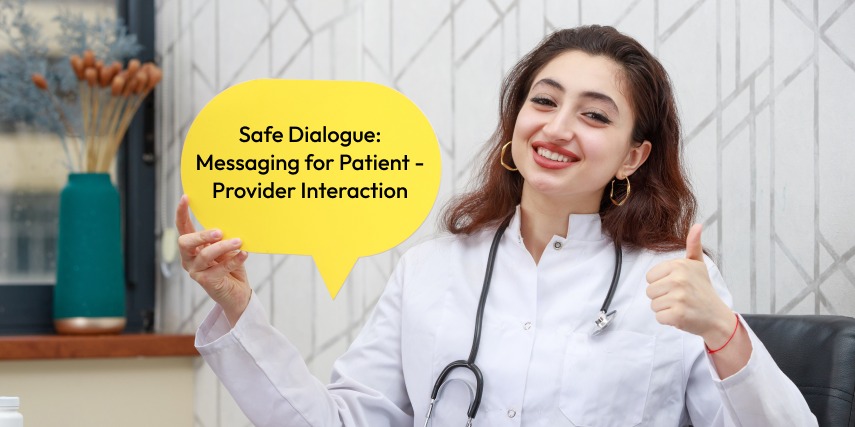Effective communication is crucial in healthcare, and advancements in technology have opened new avenues for patient-provider interaction. Messaging platforms offer a convenient and efficient way for patients to communicate with their healthcare providers, allowing for timely and secure dialogue. In this blog post, we will explore the benefits of messaging for patient-provider interaction and discuss how it can enhance the safety and quality of healthcare communication.
Convenient and Timely Communication
Messaging platforms provide patients with a convenient and efficient means of communicating with their healthcare providers. Patients can send messages securely from their smartphones or computers, eliminating the need for phone calls or in-person visits for non-urgent matters.
This convenience allows patients to seek clarification, ask questions, or provide updates at their own convenience, enabling a timely response from their healthcare provider. Patients no longer have to wait for appointments or navigate phone queues to relay important information or seek medical advice.
Enhanced Patient Engagement
Messaging platforms promote patient engagement by fostering a continuous and streamlined flow of communication between patients and healthcare providers. Patients feel empowered and are more likely to actively participate in their healthcare when they have a direct line of communication with their providers.
Through messaging, patients can engage in meaningful dialogue, discuss treatment plans, share concerns, and receive guidance, all of which contribute to improved patient outcomes and satisfaction.
Streamlined Practice Management
Messaging platforms not only benefit patients but also significantly streamline practice management for healthcare providers . They can efficiently handle patient communications, manage appointments, and track patient progress all within the same platform. This eradicates the need for multiple applications or platforms, reducing administrative load and enabling a more coordinated approach to patient care.
The seamless integration of messaging with other practice management functions also enhances data security, as all patient information is housed within a single, secure platform. This efficient system ultimately leads to better patient outcomes and a smoother healthcare experience.
Accessibility and Inclusion
Messaging platforms have the potential to make healthcare more accessible and inclusive for various populations. Patients with physical disabilities, mobility limitations, or geographical constraints may face challenges when accessing in-person care.
Messaging platforms bridge these gaps by enabling individuals to connect with their healthcare providers remotely, ensuring that everyone has equitable access to healthcare services. Additionally, messaging platforms can be beneficial for patients with communication difficulties or language barriers, as they can use translation tools or take their time to compose messages effectively.
Privacy and Security
Privacy and security are paramount in healthcare communication, and messaging platforms prioritize patient confidentiality. These platforms employ robust encryption and security measures to protect patient data and ensure compliance with healthcare privacy regulations, such as HIPAA in the United States.
By utilizing secure messaging platforms, patients can have peace of mind knowing that their personal health information is safeguarded during electronic communication with their healthcare providers.
Efficient Care Coordination
Messaging platforms facilitate efficient care coordination among healthcare teams. Providers can use messaging to communicate internally, share test results, discuss treatment plans, and coordinate referrals or follow-up care.
This seamless and efficient communication enhances collaboration and ensures that all members of the healthcare team are well-informed and working towards a common goal of providing comprehensive care to the patient.
Documentation and Continuity of Care
Using messaging platforms allows for clear documentation of patient-provider interactions. Both patients and providers have a record of the conversation, including questions, answers, and any instructions or recommendations provided.
This documentation serves as a reference point for future appointments or follow-ups, ensuring continuity of care. It also aids in accurate medical record keeping, reducing the risk of miscommunication or forgetting important details during subsequent encounters.
Setting Clear Expectations and Boundaries
To ensure safe and effective use of messaging platforms, it is essential to establish clear expectations and boundaries for communication. Healthcare providers should communicate guidelines to patients, explaining the appropriate use of messaging platforms, response times, and the types of issues suitable for messaging.
Setting these expectations helps manage patient expectations and ensures that messaging is used appropriately, avoiding confusion or frustration on both sides.
Messaging platforms have transformed patient-provider interaction, offering convenience, timeliness, and enhanced engagement in healthcare communication. By leveraging secure messaging platforms, patients can communicate with their healthcare providers efficiently and securely, leading to improved patient outcomes and satisfaction. Messaging platforms promote accessibility, inclusivity, and continuity of care while respecting patient privacy and security. As healthcare continues to evolve, messaging platforms will play an increasingly vital role in fostering safe dialogue and strengthening the patient-provider relationship.

